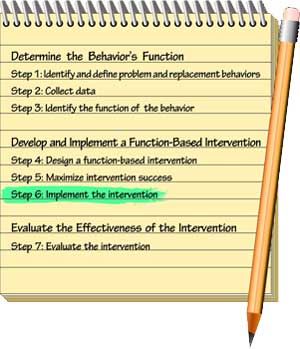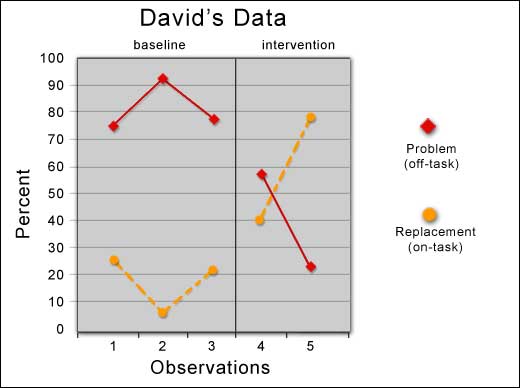What can Ms. Rollison do to modify Joseph’s behavior?
Page 11: Implement the Intervention
 The next step in the FBA process is to implement the intervention. The teacher needs to implement all of the steps outlined in the function-based intervention plan and continue to collect data on the problem and replacement behaviors. As teachers implement the intervention, they should keep several things in mind:
The next step in the FBA process is to implement the intervention. The teacher needs to implement all of the steps outlined in the function-based intervention plan and continue to collect data on the problem and replacement behaviors. As teachers implement the intervention, they should keep several things in mind:
Collecting data on problem and replacement behaviors
Recall that you have already collected baseline data. Using the same graph:
- Draw a vertical line separating the baseline from the intervention data. Make sure to clearly label the baseline and intervention phases.
- Plot the intervention data on a graph. Each data point represents one observation. A team member, the teacher, or the student can graph the data.
- Connect the data points for each observation with a line. The data points and lines for the problem and replacement behaviors should be separate and clearly identifiable (e.g., solid and dashed lines, different colors). Data points should not be connected between the baseline and intervention phases.

David’s Data graph: This line plot graph shows David’s Data. The x-axis is labeled “Observations”; observations 1 through 5 are labeled on the axis. The y-axis is labeled “percent”; 0 to 100 percent is labeled in 10-percent intervals. The graph is divided into two columns, after the third observation. The left column of the graph is labeled “baseline” and the right column of the graph is labeled “intervention.” The first graph of the baseline column is yellow and labeled as “Replacement (on-task)” in the key to the right of the graph. This graph has three plot points corresponding with the three observations. The points are at 25%, 5%, and 22%. The second graph of the baseline column is red and labeled “Problem behavior (off-task).” This graph has three plot points corresponding with the three observations. The points are at 75%, 92%, and 78%. The first graph of the intervention column is yellow and labeled “Replacement (on-task)” in the key to the right of the graph. This graph has two plot points corresponding to the two observations. The points are at 40% and 79%. The second graph of the intervention column is red and labeled “Problem behavior (off-task).” This graph has two plot points corresponding with the two observations. The points are at 59% and 21%.
(Close this panel)
- The intervention should be implemented every day; however, data might not be collected as frequently.
- Changes in behavior often take time. It is important to stick with the intervention plan for the specified period or until the behavioral goal is achieved.
- In some cases, behaviors (e.g., attention seeking) will intensify before decreasing.
- Environmental factors (e.g., implementing a new seating plan, changes in routine, the enrollment of a new student) can impinge upon the effectiveness of the intervention plan.
- Behavior may be more easily modified if the student is actively involved and has some ownership in the intervention process.
 After the behavior reaches the desired level (i.e., the goal indicated in the function-based intervention plan), withdrawal of the intervention, generalization, and maintenance should be carefully planned.
After the behavior reaches the desired level (i.e., the goal indicated in the function-based intervention plan), withdrawal of the intervention, generalization, and maintenance should be carefully planned.
For Your Information
Some students may need other supports, in addition to a function-based intervention, to help them to succeed. For example:
- School counselors or school psychologists can provide counseling for students struggling with emotional challenges.
- Speech/ language pathologists can improve a student’s receptive and expressive language skills, helping to improve both classroom performance and social interactions.
- School social workers can provide crisis prevention and intervention for students and their families.
Many students with disabilities—particularly those with emotional or behavioral disorders—have IEPs that contain behavioral intervention plans, which provide individualized procedures to prevent undesirable behaviors or to intervene when those behaviors occur. An FBA is conducted as part of this plan. If a student with a disability violates the school’s conduct codes, the student’s IEP team must meet to determine whether the behavior was the result of either:
- The student’s disability
- Poor implementation of the student’s IEP